Multi-Sensor InSAR Assessment of Ground Deformations around Lake Mead and Its Relation to Water Level Changes
Abstract
1. Introduction
2. Study Area, Geological Setting, and Datasets
2.1. Study Area
2.2. Geological Setting
2.3. Datasets
2.3.1. SAR Data
2.3.2. Geodetic GPS Data
2.3.3. Water Level Data
3. Methods
3.1. InSAR Processing—Lake Mead
3.2. InSAR Processing—Hoover Dam Site
4. Results
4.1. Ground Deformation around the Reservoir and Water Level
4.2. Relationships between Water Level and Ground Deformation
4.3. Deformation of the Dam and Water Level Changes
5. Discussion
6. Conclusions
Supplementary Materials
Author Contributions
Funding
Acknowledgments
Conflicts of Interest
References
- Dill, R.; Klemann, V.; Martinec, Z.; Tesauro, M. Applying local Green’s functions to study the influence of the crustal structure on hydrological loading displacements. J. Geodyn. 2015, 88, 14–22. [Google Scholar] [CrossRef]
- Yuill, B.; Lavoie, D.; Reed, D.J. Understanding Subsidence Processes in Coastal Louisiana. J. Coast. Res. 2009, 10054, 23–36. [Google Scholar] [CrossRef]
- Herring, T.A.; Melbourne, T.I.; Murray, M.H.; Floyd, M.; Szeliga, W.; King, R.W.; Phillips, D.A.; Puskas, C.; Santillan, M.; Wang, L. Plate Boundary Observatory and related networks: GPS data analysis methods and geodetic products. Rev. Geophys. 2016, 54, 759–808. [Google Scholar] [CrossRef]
- Hydrologic Loading Model Displacements from the National and Global Data Assimilation Systems (NLDAS and GLDAS) 2017. Available online: www.unavco.org/data/displacement-model-readme (accessed on 25 September 2020).
- Castellazzi, P.; Garfias, J.; Martel, R.; Brouard, C.; Rivera, A. InSAR to support sustainable urbanization over compacting aquifers: The case of Toluca Valley, Mexico. Int. J. Appl. Earth Obs. Geoinf. 2017, 63, 33–44. [Google Scholar] [CrossRef]
- Chaussard, E.; Wdowinski, S.; Cabral-Cano, E.; Amelung, F. Land subsidence in central Mexico detected by ALOS InSAR time-series. Remote Sens. Environ. 2014, 140, 94–106. [Google Scholar] [CrossRef]
- Ezquerro, P.; Matteo, D.S.; Solari, P.L.; Tomás, R.; Raspini, F.; Ceccatelli, M.; Fernández-Merodo, J.; Casagli, N.; Herrera, G. Vulnerability Assessment of Buildings due to Land Subsidence Using InSAR Data in the Ancient Historical City of Pistoia (Italy). Sensors 2020, 20, 2749. [Google Scholar] [CrossRef]
- Rezaei, A.; Mousavi, Z. Characterization of land deformation, hydraulic head, and aquifer properties of the Gorgan confined aquifer, Iran, from InSAR observations. J. Hydrol. 2019, 579, 124196. [Google Scholar] [CrossRef]
- Cui, P.; Zhu, X. Surge generation in reservoirs by landslides triggered by the wenchuan earthquake. J. Earthq. Tsunami 2011, 5, 461–474. [Google Scholar] [CrossRef]
- Kaczmarek, H.; Tyszkowski, S.; Banach, M. Landslide development at the shores of a dam reservoir (Włocławek, Poland), based on 40 years of research. Environ. Earth Sci. 2015, 74, 4247–4259. [Google Scholar] [CrossRef]
- Reyes-Carmona, C.; Barra, A.; Galve, J.P.; Monserrat, O.; Pérez-Peña, J.V.; Mateos, R.; Notti, D.; Ruano, P.; Millares, A.; López-Vinielles, J.; et al. Sentinel-1 DInSAR for Monitoring Active Landslides in Critical Infrastructures: The Case of the Rules Reservoir (Southern Spain). Remote Sens. 2020, 12, 809. [Google Scholar] [CrossRef]
- Zhou, C.; Cao, Y.; Yin, K.; Wang, Y.; Shi, X.; Catani, F.; Ahmed, B. Landslide Characterization Applying Sentinel-1 Images and InSAR Technique: The Muyubao Landslide in the Three Gorges Reservoir Area, China. Remote Sens. 2020, 12, 3385. [Google Scholar] [CrossRef]
- Chaussard, E.; Farr, T.G. A New Method for Isolating Elastic From Inelastic Deformation in Aquifer Systems: Application to the San Joaquin Valley, CA. Geophys. Res. Lett. 2019, 46, 10800–10809. [Google Scholar] [CrossRef]
- Van Dam, T.; Wahr, J.; Milly, P.C.; Shmakin, A.B.; Blewitt, G.; Lavallée, D.; Larson, K.M. Crustal displacements due to continental water loading. Geophys. Res. Lett. 2001, 28, 651–654. [Google Scholar] [CrossRef]
- Meertens, C.M.; Puskas, C.M.; Molnar, C.; Phillips, D.A. Analysis of Drought-Related Hydrologic Loading Signals from Plate Boundary Observatory GPS Stations in the Sierra Nevada Mountains; UNAVCO, Inc.: Boulder, CO, USA, 2016. [Google Scholar]
- Galloway, D.L.; Jones, D.R.; Ingebritsen, S.E. Land Subsidence in the United States; US Geological Survey: Denver, CO, USA, 1999; Volume 1182.
- Terzaghi, K.; Peck, R.B.; Mesri, G. Soil Mechanics in Engineering Practice; John Wiley & Sons: Hoboken, NJ, USA, 1996. [Google Scholar]
- Eriksson, D.; Macmillan, D.S. Continental hydrology loading observed by VLBI measurements. J. Geod. 2014, 88, 675–690. [Google Scholar] [CrossRef]
- van Dam, T.; Collieux, X.; Altamimi, Z.; Ray, J. A review of GPS and GRACE estimates of surface mass loading effects. In Proceedings of the European Geosciences Union General Assembly 2011, Vienna, Austria, 3–8 April 2011. [Google Scholar]
- Gahalaut, V.; Yadav, R.K.; Sreejith, K.; Gahalaut, K.; Burgmann, R.; Agrawal, R.; Sati, S.; Kumar, A. InSAR and GPS measurements of crustal deformation due to seasonal loading of Tehri reservoir in Garhwal Himalaya, India. Geophys. J. Int. 2017, 209, 425–433. [Google Scholar] [CrossRef][Green Version]
- Jaramillo, F.; Brown, I.; Castellazzi, P.; Espinosa, L.F.; Guittard, A.; Hong, S.-H.; Rivera-Monroy, V.H.; Wdowinski, S. Assessment of hydrologic connectivity in an ungauged wetland with InSAR observations. Environ. Res. Lett. 2018, 13, 024003. [Google Scholar] [CrossRef]
- Liu, D.; Wang, X.; Jaramillo, F.; Yi, Y.; Li, C.; Yang, Z. A probabilistic conceptual model to attribute runoff variations to human activity. Hydrol. Sci. J. 2020. [Google Scholar] [CrossRef]
- Palomino-Ángel, S.; Anaya, J.A.; Simard, M.; Liao, T.-H.; Jaramillo, F. Analysis of Floodplain Dynamics in the Atrato River Colombia Using SAR Interferometry. Water 2019, 11, 875. [Google Scholar] [CrossRef]
- Ruiz-Armenteros, A.M.; Lazecky, M.; Hlaváčová, I.; Bakoň, M.; Delgado, J.M.; Sousa, J.J.; Lamas-Fernández, F.; Marchamalo, M.; Caro-Cuenca, M.; Papco, J.; et al. Deformation monitoring of dam infrastructures via spaceborne MT-InSAR. The case of La Viñuela (Málaga, southern Spain). Procedia Comput. Sci. 2018, 138, 346–353. [Google Scholar] [CrossRef]
- Darvishi, M.; Schlögel, R.; Bruzzone, L.; Cuozzo, G. Integration of PSI, MAI, and Intensity-Based Sub-Pixel Offset Tracking Results for Landslide Monitoring with X-Band Corner Reflectors—Italian Alps (Corvara). Remote Sens. 2018, 10, 409. [Google Scholar] [CrossRef]
- Hanssen, R.F. Radar Interferometry: Data Interpretation and Error Analysis; Springer Science & Business Media: Dordrecht, The Netherlands, 2001; Volume 1. [Google Scholar]
- Darvishi, M.; Cuozzo, G.; Bruzzone, L.; Nilfouroushan, F. Performance evaluation of phase and weather-based models in atmospheric correction with Sentinel-1data: Corvara landslide in the Alps. IEEE J. Sel. Top. Appl. Earth Obs. Remote Sens. 2020, 13, 1332–1346. [Google Scholar] [CrossRef]
- Solano-Rojas, D.; Wdowinski, S.; Cabral-Cano, E.; Osmanoğlu, B. Detecting differential ground displacements of civil structures in fast-subsiding metropolises with interferometric SAR and band-pass filtering. Sci. Rep. 2020, 10, 1–14. [Google Scholar] [CrossRef] [PubMed]
- Bell, J.W.; Amelung, F.; Ferretti, A.; Bianchi, M.; Novali, F. Permanent scatterer InSAR reveals seasonal and long-term aquifer-system response to groundwater pumping and artificial recharge. Water Resour. Res. 2008, 44. [Google Scholar] [CrossRef]
- Motagh, M.; Walter, T.R.; Sharifi, M.A.; Fielding, E.; Schenk, A.; Anderssohn, J.; Zschau, J. Land subsidence in Iran caused by widespread water reservoir overexploitation. Geophys. Res. Lett. 2008, 35, 16403. [Google Scholar] [CrossRef]
- Calderhead, A.I.; Martel, A.; Alasset, P.-J.; Rivera, A.; Garfias, J. Land subsidence induced by groundwater pumping, monitored by D-InSAR and field data in the Toluca Valley, Mexico. Can. J. Remote Sens. 2010, 36, 9–23. [Google Scholar] [CrossRef]
- Calderhead, A.I.; Therrien, R.; Rivera, A.; Martel, R.; Garfias, J. Simulating pumping-induced regional land subsidence with the use of InSAR and field data in the Toluca Valley, Mexico. Adv. Water Resour. 2011, 34, 83–97. [Google Scholar] [CrossRef]
- Erban, E.L.; Gorelick, S.M.; Zebker, A.H. Groundwater extraction, land subsidence, and sea-level rise in the Mekong Delta, Vietnam. Environ. Res. Lett. 2014, 9, 084010. [Google Scholar] [CrossRef]
- Castellazzi, P.; Martel, R.; Rivera, A.; Huang, J.; Pavlic, G.; Calderhead, A.I.; Chaussard, E.; Garfias, J.; Salas, J. Groundwater depletion in Central Mexico: Use of GRACE and InSAR to support water resources management. Water Resour. Res. 2016, 52, 5985–6003. [Google Scholar] [CrossRef]
- Ruiz-Constán, A.; Ruiz-Armenteros, A.M.; Lamas-Fernández, F.; Martos-Rosillo, S.; Delgado, J.M.; Bekaert, D.P.S.; Sousa, J.J.; Gil, A.J.; Cuenca, M.C.; Hanssen, R.F.; et al. Multi-temporal InSAR evidence of ground subsidence induced by groundwater withdrawal: The Montellano aquifer (SW Spain). Environ. Earth Sci. 2016, 75, 1–16. [Google Scholar] [CrossRef]
- Bejar-Pizarro, M.; Ezquerro, P.; Herrera, G.; Tomás, R.; Guardiola-Albert, C.; Hernández, J.M.R.; Fernández-Merodo, J.; Marchamalo, M.; Martínez, R. Mapping groundwater level and aquifer storage variations from InSAR measurements in the Madrid aquifer, Central Spain. J. Hydrol. 2017, 547, 678–689. [Google Scholar] [CrossRef]
- Siles, G.; Trudel, M.; Peters, D.L.; Leconte, R. Hydrological monitoring of high-latitude shallow water bodies from high-resolution space-borne D-InSAR. Remote Sens. Environ. 2020, 236, 111444. [Google Scholar] [CrossRef]
- Saleh, M.; Masson, F.; Mohamed, A.-M.S.; Boy, J.-P.; Abou-Aly, N.; Rayan, A. Recent ground deformation around lake Nasser using GPS and InSAR, Aswan, Egypt. Tectonophysics 2018, 744, 310–321. [Google Scholar] [CrossRef]
- Zhao, W.; Amelung, F.; Doin, M.-P.; Dixon, T.H.; Wdowinski, S.; Lin, G. InSAR observations of lake loading at Yangzhuoyong Lake, Tibet: Constraints on crustal elasticity. Earth Planet. Sci. Lett. 2016, 449, 240–245. [Google Scholar] [CrossRef]
- Zhou, J.; Li, Z.; He, X.; Tian, B.; Huang, L.; Chen, Q.; Xing, Q. Glacier Thickness Change Mapping Using InSAR Methodology. IEEE Geosci. Remote Sens. Lett. 2013, 11, 44–48. [Google Scholar] [CrossRef]
- Zhao, W.; Amelung, F.; Dixon, T.H.; Wdowinski, S. Sensing the bed-rock movement due to ice unloading from space using InSAR time-series. AGU Fall Meet. Abstr. 2014, 1, 0322. [Google Scholar]
- Liu, L.; Wahr, J.; Howat, I.M.; Khan, S.A.; Joughin, I.; Furuya, M. Constraining ice mass loss from Jakobshavn Isbrae (Greenland) using InSAR-measured crustal uplift. Geophys. J. Int. 2012, 188, 994–1006. [Google Scholar] [CrossRef][Green Version]
- Furuya, M.; Wahr, J.M. Water level changes at an ice-dammed lake in west Greenland inferred from InSAR data. Geophys. Res. Lett. 2005, 32. [Google Scholar] [CrossRef]
- Cavalié, O.; Doin, M.-P.; Lasserre, C.; Briole, P. Ground motion measurement in the Lake Mead area, Nevada, by differential synthetic aperture radar interferometry time series analysis: Probing the lithosphere rheological structure. J. Geophys. Res. Space Phys. 2007, 112, 1–18. [Google Scholar] [CrossRef]
- Kaufmann, G.; Amelung, F. Reservoir-induced deformation and continental rheology in vicinity of Lake Mead, Nevada. J. Geophys. Res. Space Phys. 2000, 105, 16341–16358. [Google Scholar] [CrossRef]
- Neelmeijer, J.; Schöne, T.; Dill, R.; Klemann, V.; Motagh, M. Ground Deformations around the Toktogul Reservoir, Kyrgyzstan, from Envisat ASAR and Sentinel-1 Data—A Case Study about the Impact of Atmospheric Corrections on InSAR Time Series. Remote Sens. 2018, 10, 462. [Google Scholar] [CrossRef]
- Geod, D. Daniel Wujanz Terrestrial Laser Scanning for Geodetic Deformation Monitoring; Technische Universitaet Berlin: Berlin, Germany, 2016; ISBN 9783769651874. [Google Scholar]
- Milillo, P.; Perissin, D.; Salzer, J.T.; Lundgren, P.; Lacava, G.; Milillo, G.; Di Serio, C. Monitoring dam structural health from space: Insights from novel InSAR techniques and multi-parametric modeling applied to the Pertusillo dam Basilicata, Italy. Int. J. Appl. Earth Obs. Geoinf. 2016, 52, 221–229. [Google Scholar] [CrossRef]
- Zhou, W.; Li, S.; Zhou, Z.; Chang, X. InSAR Observation and Numerical Modeling of the Earth-Dam Displacement of Shuibuya Dam (China). Remote Sens. 2016, 8, 877. [Google Scholar] [CrossRef]
- Milillo, P.; Bürgmann, R.; Lundgren, P.; Salzer, J.; Perissin, D.; Fielding, E.; Biondi, F.; Milillo, G. Space geodetic monitoring of engineered structures: The ongoing destabilization of the Mosul dam, Iraq. Sci. Rep. 2016, 6, 37408. [Google Scholar] [CrossRef]
- Turner, K.; Rosen, M.R.; Holdren, G.C.; Goodbred, S.L.; Twichell, D.C. Environmental Setting of Lake Mead National Recreation Area: Chapter 2 in A synthesis of Aquatic Science for Management of Lakes Mead and Mohave; US Geological Survey: Reston, VA, USA, 2012; No. 1381-2; pp. 7–22.
- Christensen, N.S.; Lettenmaier, D.P. A multimodel ensemble approach to assessment of climate change impacts on the hydrology and water resources of the Colorado River Basin. Hydrol. Earth Syst. Sci. 2007, 11, 1417–1434. [Google Scholar] [CrossRef]
- Livneh, B.; Rosenberg, E.A.; Lin, C.; Nijssen, B.; Mishra, V.; Andreadis, K.M.; Maurer, E.P.; Lettenmaier, D.P. A Long-Term Hydrologically Based Dataset of Land Surface Fluxes and States for the Conterminous United States: Update and Extensions. J. Clim. 2013, 26, 9384–9392. [Google Scholar] [CrossRef]
- Hoover-Dam-Photo. Available online: https://www.usbr.gov/lc/hooverdam/ (accessed on 20 September 2020).
- Felger, T.J.; Beard, L.S.; Umhoefer, P.J.; Lamb, M.A. Geologic map of Lake Mead and surrounding regions, southern Nevada, southwestern Utah, and northwestern Arizona. Geol. Soc. Am. Spec. Papers 2010, 463, 29–38. [Google Scholar] [CrossRef]
- Twichell, D.C.; Cross, V.A.; Rudin, M.J.; Parolski, K.F. Surficial Geology and Distribution of Post-Impoundment Sediment of the Western Part of Lake Mead Based on a Sidescan Sonar and High-Resolution Seismic-Reflection Survey (No. 99-581); US Geological Survey: Reston, VA, USA, 1999.
- Angelier, J.; Colletta, B.; Anderson, R.E. Neogene paleostress changes in the Basin and Range: A case study at Hoover Dam, Nevada-Arizona. GSA Bull. 1985, 96, 347–361. [Google Scholar] [CrossRef]
- Berardino, P.; Fornaro, G.; Lanari, R.; Sansosti, E. A new algorithm for surface deformation monitoring based on small baseline differential SAR interferograms. IEEE Trans. Geosci. Remote Sens. 2002, 40, 2375–2383. [Google Scholar] [CrossRef]
- Ferretti, A.; Prati, C.; Rocca, F. Permanent scatterers in SAR interferometry. IEEE Trans. Geosci. Remote Sens. 2001, 39, 8–20. [Google Scholar] [CrossRef]
- Blewitt, G.; Hammond, W.C. Harnessing the GPS Data Explosion for Interdisciplinary Science. Eos 2018, 99, 1–2. [Google Scholar] [CrossRef]
- Revelle, R.; Waggoner, P. Effects of a Carbon Dioxide-Induced Climatic Change on Water Supplies in 7 the Western United States. Month 1983, 419, 432. [Google Scholar]
- Sensitivity_of_streamflow_in_the_Colorado 1991. Available online: https://www.gleick.com/ (accessed on 25 September 2020).
- Seager, R.; Ting, M.; Held, I.; Kushnir, Y.; Lu, J.; Vecchi, G.; Huang, H.-P.; Harnik, N.; Leetmaa, A.; Lau, N.-C.; et al. Model Projections of an Imminent Transition to a More Arid Climate in Southwestern North America. Science 2007, 316, 1181–1184. [Google Scholar] [CrossRef] [PubMed]
- Mead-Lake-Water-Level-Data. Available online: https://lakemead.water-data.com/ (accessed on 25 September 2020).
- Pepe, A.; Lanari, R. On the Extension of the Minimum Cost Flow Algorithm for Phase Unwrapping of Multitemporal Differential SAR Interferograms. IEEE Trans. Geosci. Remote Sens. 2006, 44, 2374–2383. [Google Scholar] [CrossRef]
- Fialko, Y.; Simons, M.; Agnew, D. The complete (3-D) surface displacement field in the epicentral area of the 1999MW7.1 Hector Mine Earthquake, California, from space geodetic observations. Geophys. Res. Lett. 2001, 28, 3063–3066. [Google Scholar] [CrossRef]
- Peter, H.; Jäggi, A.; Fernández, J.; Escobar, D.; Ayuga, F.; Arnold, D.; Wermuth, M.; Hackel, S.; Otten, M.; Simons, W.; et al. Sentinel-1A—First precise orbit determination results. Adv. Space Res. 2017, 60, 879–892. [Google Scholar] [CrossRef]
- DEM(10-m). Available online: https://viewer.nationalmap.gov/basic. (accessed on 25 September 2020).
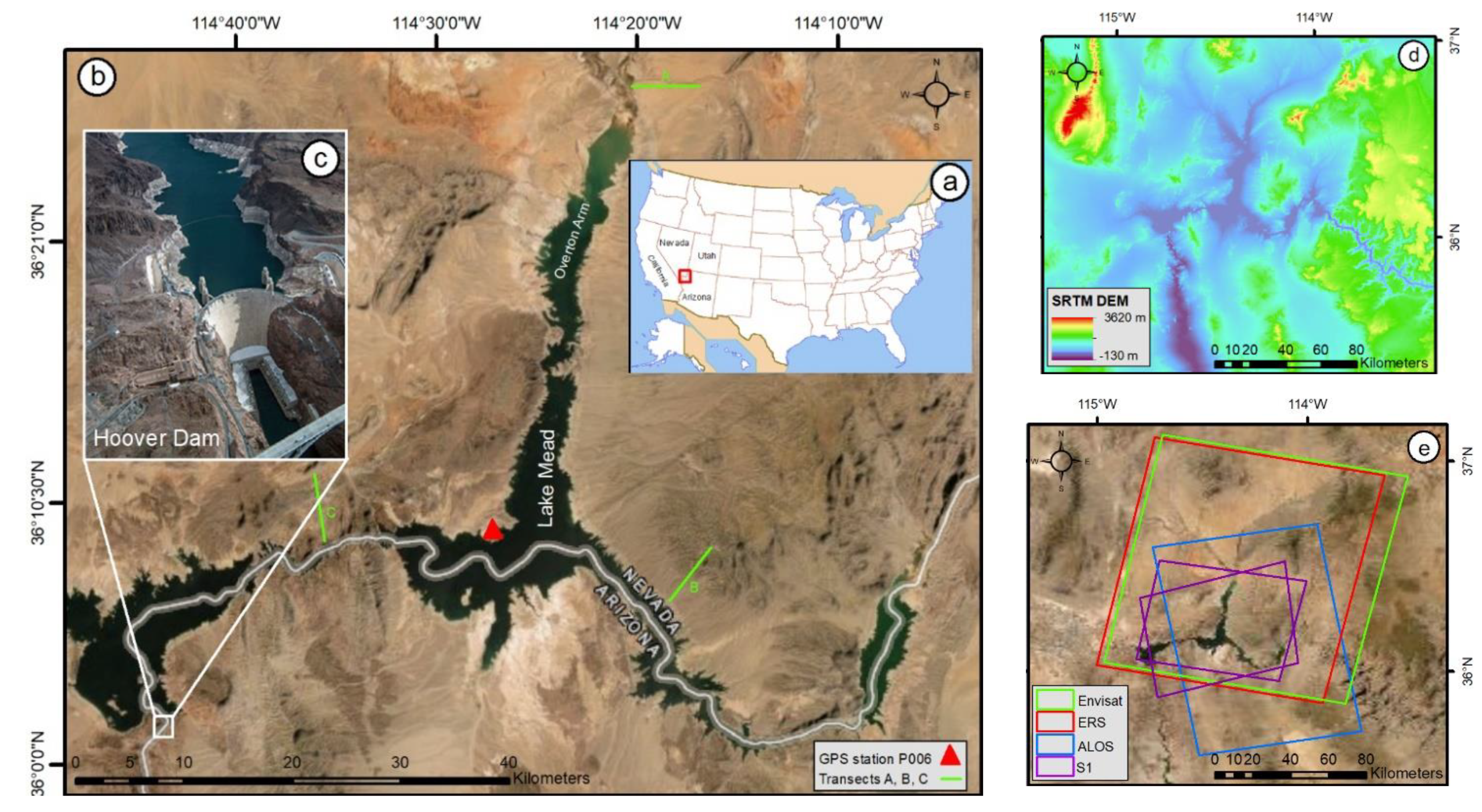

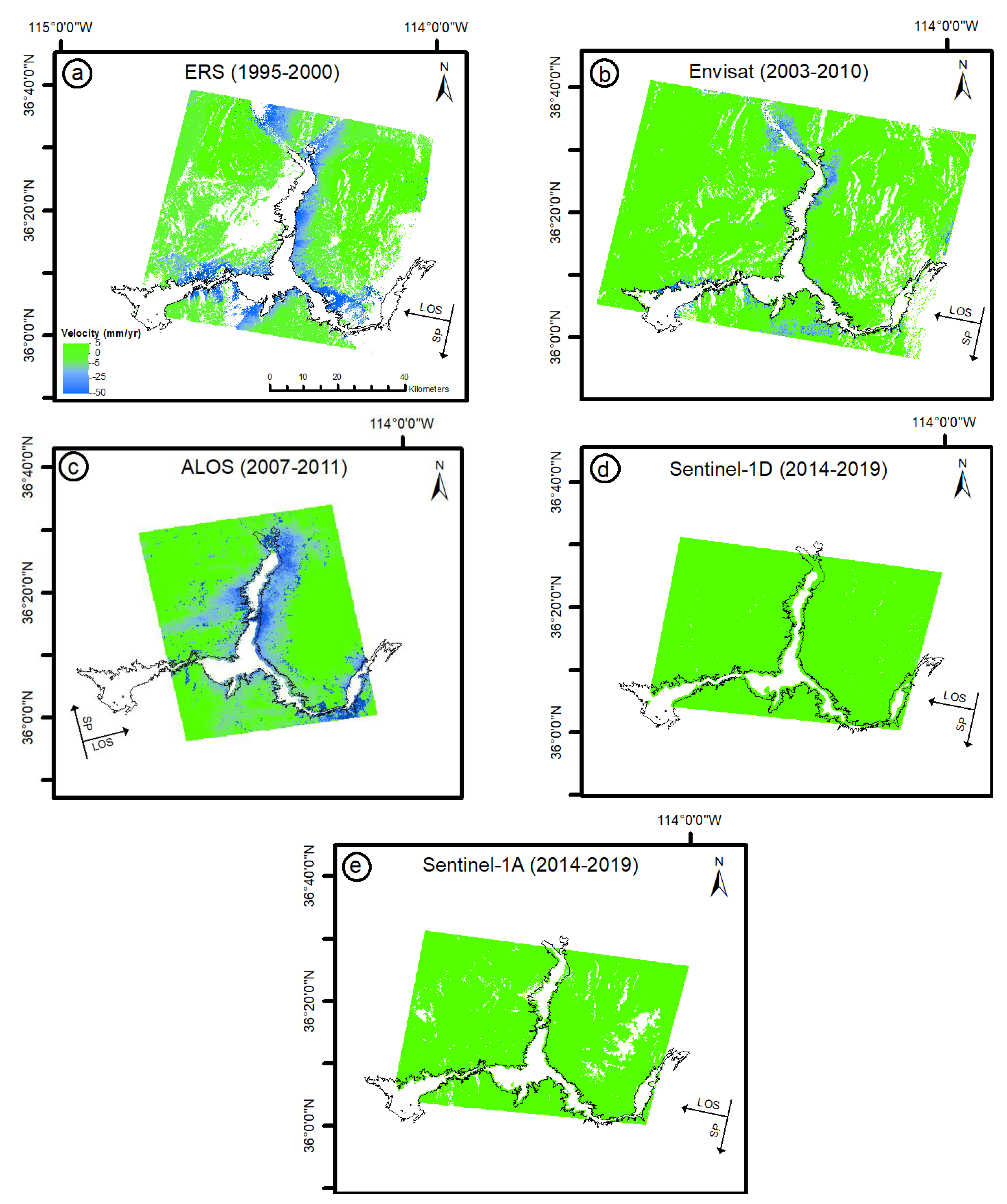
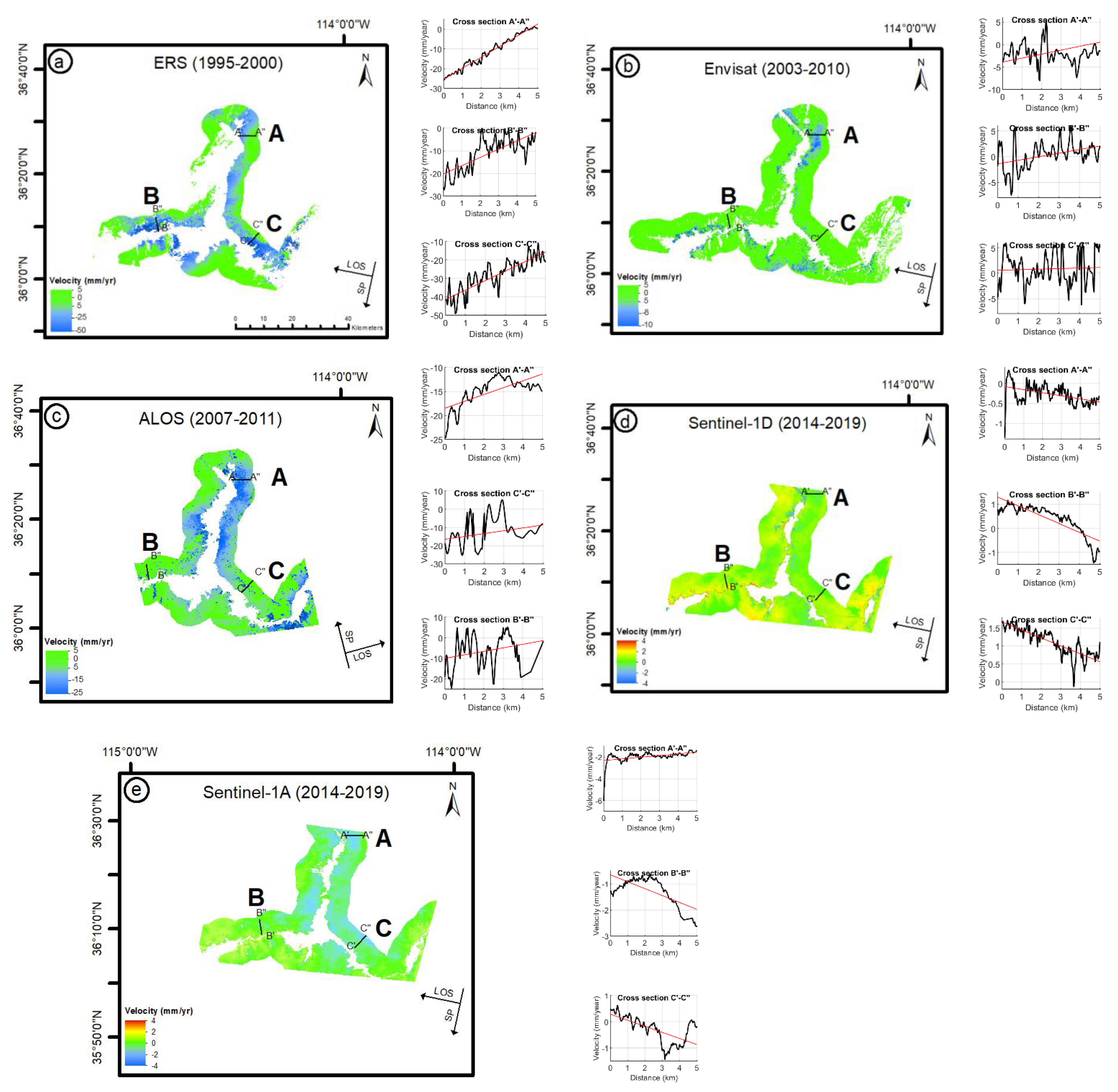
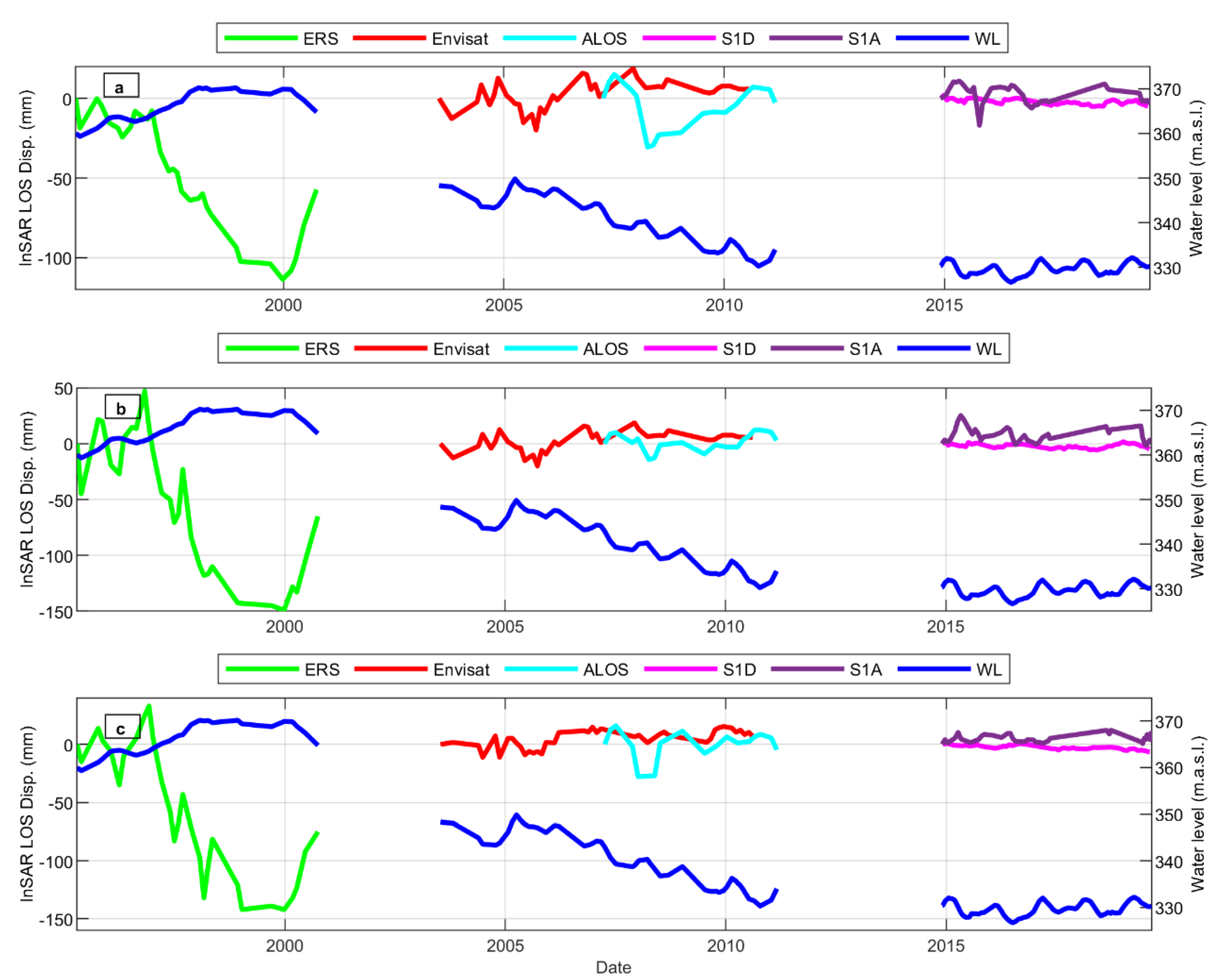

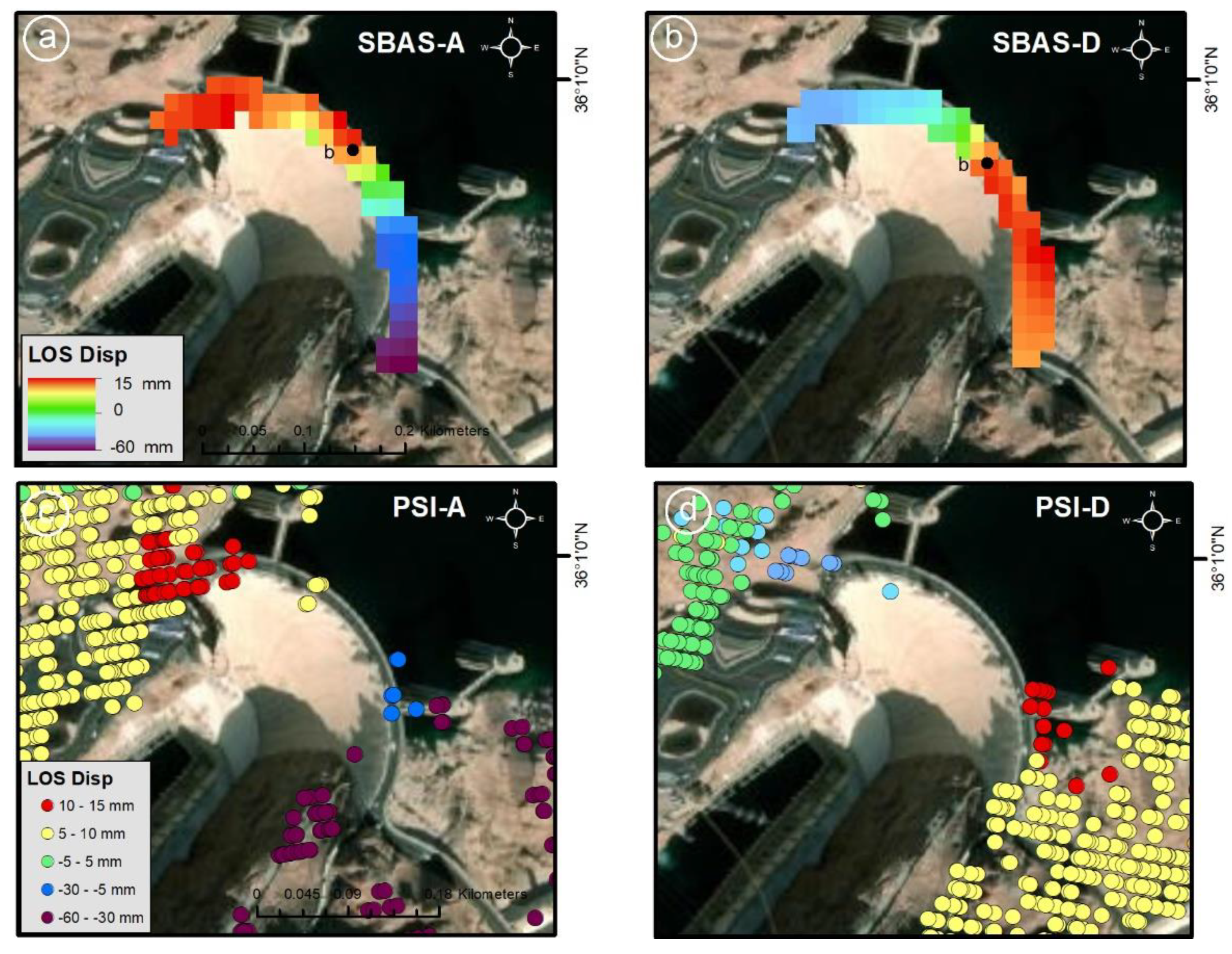

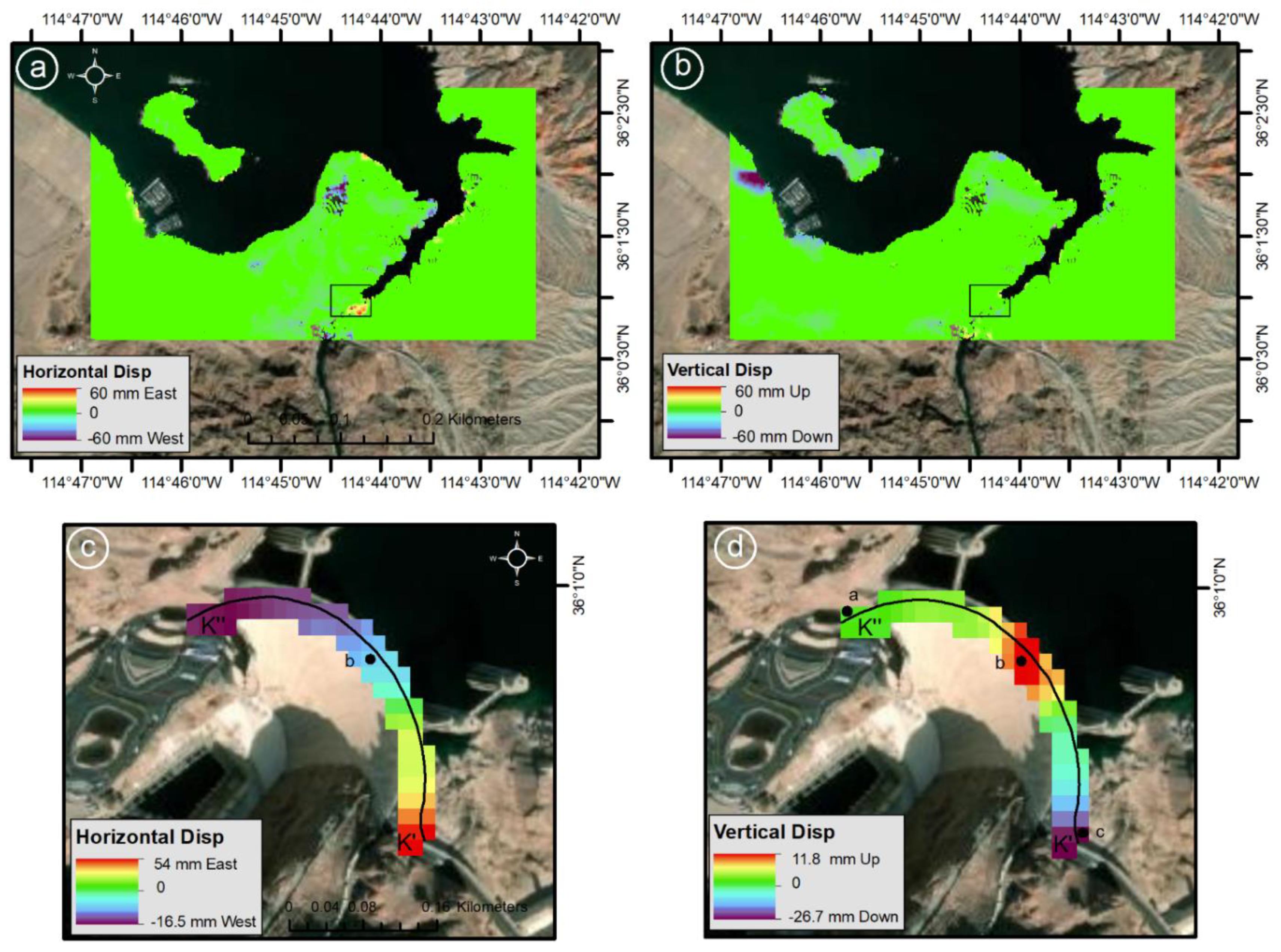

| Product Type | Period | No. | Mode | Po. | Rt |
|---|---|---|---|---|---|
| ERS1/2 | 1995–2000 | 30 | D | VV | 35 |
| Envisat | 2003–2010 | 40 | D | VV | 35 |
| ALOS | 2007–2011 | 19 | A | HH | 46 |
| S1A/B | 2014–2019 | 49D/39A | D, A | VV | 6/12 |
| 4 sensors | 1995–2019 | 177 | - | - | - |
| ERS-W | Envisat-W | ALOS-W | S1Descending-W | S1Ascending-W | |||||||||||
|---|---|---|---|---|---|---|---|---|---|---|---|---|---|---|---|
| PT | PA | PB | PC | PA | PB | PC | PA | PB | PC | PA | PB | PC | PA | PB | PC |
| R | −0.88 | −0.87 | −0.88 | −0.49 | −0.29 | −0.55 | −0.25 | −0.31 | −0.13 | −0.13 | −0.03 | −0.34 | −0.24 | −0.29 | −0.27 |
| S1 Ascending-P006 | S1 Descending-P006 | Water Level-S1 Ascending | Water Level-S1 Descending | |||
|---|---|---|---|---|---|---|
| Station name | R | RMSE (mm) | R | RMSE (mm) | R | R |
| GPS P006 | 0.38 | 8 | 0.33 | 3 | −0.58 | −0.52 |
| Mid-Point Correlation Coefficient | PSI-SBAS Descending | PSI-SBAS Ascending | W-PSI Descending | W-PSI Ascending | W-SBAS Descending | W-SBAS Ascending |
|---|---|---|---|---|---|---|
| R | 0.59 | 0.33 | −0.56 | −0.04 | −0.51 | −0.33 |
Publisher’s Note: MDPI stays neutral with regard to jurisdictional claims in published maps and institutional affiliations. |
© 2021 by the authors. Licensee MDPI, Basel, Switzerland. This article is an open access article distributed under the terms and conditions of the Creative Commons Attribution (CC BY) license (http://creativecommons.org/licenses/by/4.0/).
Share and Cite
Darvishi, M.; Destouni, G.; Aminjafari, S.; Jaramillo, F. Multi-Sensor InSAR Assessment of Ground Deformations around Lake Mead and Its Relation to Water Level Changes. Remote Sens. 2021, 13, 406. https://doi.org/10.3390/rs13030406
Darvishi M, Destouni G, Aminjafari S, Jaramillo F. Multi-Sensor InSAR Assessment of Ground Deformations around Lake Mead and Its Relation to Water Level Changes. Remote Sensing. 2021; 13(3):406. https://doi.org/10.3390/rs13030406
Chicago/Turabian StyleDarvishi, Mehdi, Georgia Destouni, Saeid Aminjafari, and Fernando Jaramillo. 2021. "Multi-Sensor InSAR Assessment of Ground Deformations around Lake Mead and Its Relation to Water Level Changes" Remote Sensing 13, no. 3: 406. https://doi.org/10.3390/rs13030406
APA StyleDarvishi, M., Destouni, G., Aminjafari, S., & Jaramillo, F. (2021). Multi-Sensor InSAR Assessment of Ground Deformations around Lake Mead and Its Relation to Water Level Changes. Remote Sensing, 13(3), 406. https://doi.org/10.3390/rs13030406










